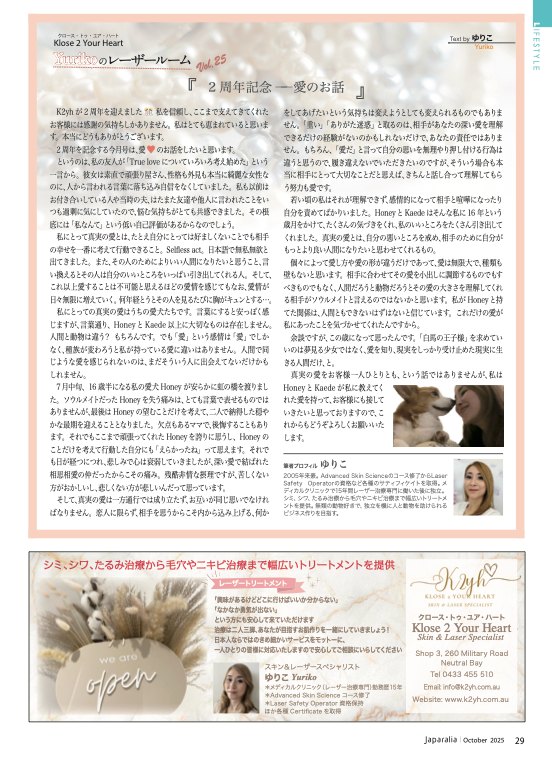Japaralia September 2024 vol.12
- Yuriko Ono
- Aug 29, 2024
- 3 min read

English translation below (Google translate used)
UV Warning
September is a pleasant spring. I'm sure those of you who have been reading my column for the past 14 years are used to hearing this, but let me say it again this year. September is a pleasant month, and it's not yet hot, but from here on out, the ultraviolet rays in Australia start to get stronger. As we come out of the cold winter, we end up spending a lot of time in the sun in the pleasant weather. However, perhaps due to the damage from this time, almost every year, there are many people whose spots get worse in October and November before even the midsummer arrives.
It seems to be improving nowadays so I've heard, but from this time on, the ozone hole moves into the sky above Australia due to the rotation of the earth. In Japan, where there is no ozone hole, there are ultraviolet rays that are absorbed by the ozone layer do not reach the ground or get weaker before they do, but here, such ultraviolet rays enter. Have you ever felt a tingling sensation on your skin when you are outside on a hot day?
I didn't feel it in Japan, but here I sometimes feel it.
Therefore, the damage to the skin caused by the ultraviolet rays in Australia is several times greater than when you are in Japan.
Also, in winter, the sun is low and the surface area where the ultraviolet rays hit is low and the area of effect is widened, so the impact is less even at the same time of the day, whereas in the summer, the sun is high and the surface area where the ultraviolet rays hit is high and the area of effect is narrowed, so the amount of energy that hits one spot increases, and the impact is greater.
I mentioned earlier that "ultraviolet rays that are absorbed by the ozone layer in Japan and do not enter the country" are ultraviolet C rays (UVC). The length of ultraviolet rays is (from the longest) UVA, UVB, and UVC, which are the shortest. UVC, which has a short length, is the most harmful, but it is absorbed by the ozone layer. However, in Australia, where there is a hole in the ozone layer, it pours onto the ground. Therefore, UVC, which could damage DNA, can cause skin cancer.
UVA, which has a long length, reaches deep into the skin, destroying collagen, causing wrinkles and sagging. Because of its long wavelength, it can pass through windows and enter rooms and places, so you can't be safe just because you're indoors. UVB, which wavelength is in between UVA and UVC, reaches close to the skin surface and causes burns. It's UVB that causes the skin to turn red and burn. UVB can also affect the inner surface of the eyes, so protect your eyes by wearing sunglasses.
Going a little deeper, remember that there are other types of radiation in the sun besides UV rays, so applying sunscreen doesn't completely protect your skin. Sunscreen creams (broad spectrum products) protect the skin from UVA and UVB, but not from other types of radiation. To protect your skin from UVC and other types of radiation, wear a hat and sunglasses, and choose a daytime environment when the sun is still high. For skin care, products containing niacinamide (vitamin B3) are also recommended to protect the skin from the effects of UV rays.
Finally, vitamin D is produced in the liver when UV rays hit the skin. (It's a mysteryr of the human body...) Customers sometimes ask me if sunscreens are bad because they will cause vitamin D deficiency. When I hear that, I tell them that it is effective in preventing skin cancer, age spots, and wrinkles, and I think you don't have to make vitamin D in your face, you can get it from your arms and legs or take vitamin D supplements.
Let's get along well with Australia's beautiful summer and I hope I can help you do so. *please talk to your doctor if you suffer from Vitamin D deficiency







Comments